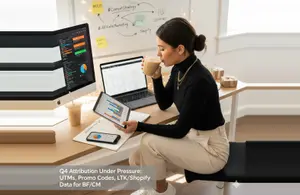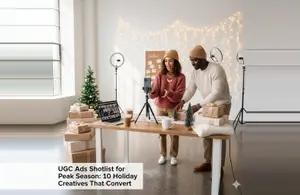Are you handing over paid rights the right way? Influencer whitelisting and TikTok Spark Ads unlock a powerful performance lever: ads that appear to originate directly from a creator’s profile rather than a brand handle.
Consider a beauty influencer whose ULTA whitelisted post leaped from 300 organic likes to 9,000, reaching two million unique users and driving seven million impressions while generating thousands of profile visits.
On TikTok, Spark Ads let brands “boost” existing creator videos under the creator’s handle, often doubling affiliate commissions in a single campaign. Yet, too many creators still grant paid rights gratis, risking misaligned targeting, damaged engagement rates, and lower algorithmic favorability.
In this article, we’ll dissect how to negotiate whitelisting fees, secure Spark Ad commissions, and structure contracts that protect both brand ROI and creator value. Master these steps to ensure authenticity, compliance, and maximum return on every paid rights activation.
Why Paid Rights Are 2025’s Performance Hack
Paid rights activations—specifically influencer whitelisting and Spark Ads on TikTok—have evolved from niche tactics into essential levers for accelerating both reach and return on ad spend (ROAS).
Agencies that once focused solely on brand-handle media are now redirecting budgets into creator handles because of the clear uplift in engagement and conversions when ads originate authentically from an influencer’s profile.
A pivotal example involves a beauty influencer with 200k followers who partnered with ULTA. When ULTA whitelisted her single-branded post, it generated about 9,000 likes, compared to her typical organic high of 150–300 likes, reached over 2 million unique users, and amassed 7 million impressions. This translated to roughly 3,000 profile visits and a sizable spike in follower growth, all while the brand’s paid media budget drove incremental revenue.
@tanicha_rose Here’s why you should be whitelisting your content👀 #influencer101 #influencertips #microinfluencertips #microinfluencertiktok #contentcreator #blackcontentcreator #branddeals ♬ original sound - Tanicha Rose
Beyond raw engagement, the whitelisting fee itself has become a revenue stream for creators. Common industry standard now dictates charging 20–25% of a content creator’s base rate per 30-day flight to grant ad permissions.
For instance, if a creator’s flat fee to produce a branded video is $10,000, adding a 25% whitelisting fee yields $2,500 per month. Over a six-month campaign, this can double the creator’s total contract value from $10,000 to $25,000—delivering a clear incentive to negotiate paid rights rather than offering them gratis.
@creatorwizardHow much to charge brands for boosting/amplification/whitelisting 🤑♬ original sound - Justin | Sponsorship Coach
On TikTok, Spark Ads provide a parallel mechanism: brands generate an “Ad Authorization” or “Spark code” that allows them to promote an influencer’s organic video under the influencer’s handle.
Creators have reported Spark Ads that boosted a pre-existing video, not only benefiting from elevated views but from higher affiliate commissions tied to TikTok Shop. One beauty creator negotiated her commission from 4% to 12% during a Spark Ads flight, earning over $1,000 in incremental commission.
@sonia.elyss Dont make this mistake! Take notes and save this: how to make money from soark ads as a creator! #contentcreatortips #sparkads #creatorpricing ♬ original sound - Sonia 💕 Creator Mentor
Furthermore, the perceived “exposure” argument brands often use to persuade creators to hand over paid rights for free has lost credibility. Creators emphasize that if ad targeting is misaligned, their engagement rate can actually decline, damaging their algorithmic favorability and overall account health.
By instead formalizing paid rights with explicit fees or revenue shares, creators and agencies align incentives: brands secure authentic-looking ad units, and creators monetize their likeness, audience trust, and content performance fully.
As we head deeper into 2025, agencies must integrate whitelisting and Spark Ads into standard media-buying blueprints. The tactics no longer serve as “nice-to-have” add-ons; they are critical performance accelerators that lift ROAS, reinforce brand authenticity, and establish new revenue lines for creators.
Influencer Whitelisting: From Contract to Live Ad
Influencer whitelisting transforms an influencer’s organic content into a paid advertisement served directly from the influencer’s own handle, leveraging inherent authenticity to drive performance.
For agency and brand marketers, whitelisting is a powerful lever to push high-intent traffic while maintaining the creator’s voice. Below, we unpack every critical step—from contract language to ad-spec execution—grounded in real data and patterns.
Contract & Pricing Guardrails
Before any ad ever goes live, the agreement between brand and creator must explicitly delineate whitelisting rights, fees, and guardrails. Standard usage language alone will not suffice; you need a standalone “Whitelisting Authorization” clause in your influencer agreements. Structure this clause around three pillars:
Explicit Whitelisting Definition
- The creator grants the brand permission to run paid ads through the creator’s account handle for a defined period.
- Prohibit brands from repurposing without labeling: “Brand may only boost the creator’s original post; captions, images, and overlays must remain unaltered unless pre-approved.”
Fee Structure Anchored to Base Rate
- Industry-standard fee: 25% of the base content-creation rate, per 30 days of boosting. For example, if the creator’s flat content fee is $ 10,000, whitelisting adds $ 2,500 per 30-day period.
- If the brand wants 60 days of whitelisting, the incremental cost is $ 5,000, making the total deal $ 15,000. Always present these numbers transparently so there’s no back-and-forth.
Renewals & Latent Activation Clause
- Include a renewal escalator to protect against year-long freebies. For instance: “If brand extends whitelisting beyond 30 days, whitelisting fee increases by 10% for each subsequent 30-day period.”
- Offer a latent clause: “Brand may, at any point within 90 days of original post date, activate whitelisting at pre-negotiated rates without renegotiation.” This ensures upfront clarity and prevents surprise fees.
Publisher-Side Setup: Meta Business Manager and Instagram
Once whitelisting terms are in your contract, the next step is to configure both creator and brand accounts so paid ads run seamlessly from the creator’s handle. Below are the precise instructions for whitelisting Instagram (Meta) and TikTok, including every toggle, menu path, and ad status check you need.
Instagram Whitelisting Setup (Meta Business Manager)
- Creator Grants Advertiser Access
- Open the Instagram app on your mobile.
- Navigate to the post you’ve agreed to whitelist. Tap the three-dot menu (⋯) above the post, then select “Ad Settings.”
- Toggle “Allow Partner to Promote” or “Paid Partnership” (wording may vary). Instagram will generate an 8-digit Authorization Code.
- Copy that code and forward it immediately to the brand’s ad-ops team—do not share via public channels or captions.
Key Point: This code is the only way the brand can target your handle directly.
Brand Links Creator Handle to Business Manager
- In Meta Business Manager (business.facebook.com), go to “Accounts” → “Instagram Accounts.”
- Click “Add” and paste the creator’s Instagram handle or Business Account ID. Ensure you assign “Advertiser” permission.
- Confirm that the creator’s handle appears under “Shared Assets” with an Active status.
Key Point: Without “Advertiser” permission, the brand cannot run any ads—even with the authorization code.
Ad Manager: Select and Promote an Existing Creator Post
- In Ads Manager, click “Create” and choose a campaign objective (e.g., Conversions or Traffic).
- Under Ad Set:
- Audience: Build a custom/lookalike audience matching the creator’s top geographic or demographic segments. Verify overlap with the creator’s engaged follower base to maintain performance.
- Budget & Schedule: Set a minimum daily budget of $25–$50. Align flight dates with any promo windows in the contract (e.g., product launch, sale period).
- Under Ad Creative:
- Select “Use Existing Post” → switch to the creator’s Instagram handle. Ads Manager will list their posts; choose the exact post you got the code for.
- Confirm the preview shows “Sponsored” under @CreatorHandle—never under the brand handle.
- Fill in Destination URL, ensuring you append UTM parameters (e.g.,
?utm_source=). - Review the caption: it must retain “#ad” or “Paid partnership with [BrandName]” in the first 3 lines. Do not override or shorten it; doing so risks FTC violations.
Key Point: If Ads Manager shows the brand handle or lacks the “Sponsored” label under the creator handle, pause and reconnect the asset—your ad will underperform if mislabeled.
Verify & Monitor
- Before hitting “Publish,” preview the full ad (desktop and mobile views) to ensure correct handle, caption disclosure, and ad placement (Feed, Stories, Reels).
- Once live, monitor CPV (Cost-per-View) and CPC (Cost-per-Click). Target CPV ≤ $0.03 and CPC ≤ $0.50 for feed content. If metrics exceed those thresholds by day 1–2, refine your audience or reduce the budget.
TikTok Spark Ads: Commission, Compliance, & Technical Steps
TikTok Spark Ads enable brands to amplify existing organic creator videos by “boosting” them as paid ads—delivering native-feel advertisements from the creator’s account. For agency and brand marketers at the bottom of the funnel, Spark Ads marry Creator Equity with precise targeting, driving traffic directly to landing pages or in-app storefronts.
Here, we dissect real insights, compliance pitfalls, and actionable set-up steps to maximize ROI while protecting both brand and creator.
Negotiating Spark Ad Rights & Commission Models
Never let brands pitch Spark Ad codes as “free exposure.” Your goal is to monetize every incremental dollar of ad spend. Two primary compensation structures emerge:
Flat Upfront Licensing Fee
- Example: “Charge $500/month for the Spark Ad code, irrespective of spend.” This is simplest if brand budgets are fixed.
- If the flight extends to 60 days, add $ 1,000 to the total. Always specify “per month” durations.
Performance-Based Commission
- Base TikTok Shop commission: typically 4 %. But brands can increase this on a per-video basis.
- Creator Success: Creator’s commission rose from 4% to 12% during the Spark Ad flight and netted $ 1,000 additional revenue.
- Always negotiate “minimum guaranteed commission” (e.g., + 8 pp over base) or a blended rev-share: “10% of gross sales attributed to spark-boosted video.” If the brand refuses, gauging ad spend transparency is key—you need visibility into actual ad dollars allocated.
Key Takeaway: Never give Spark Ad codes away for free.
@lauracollazoonline Replying to @Aisha | BossMomLife | UGC Here’s a quick Q/A on all things whitelisting and spark ads 👩🏫 *Disclaimer: filmed this a while back but I’m really bad at editing my own content fast, so really sorry and happy to answer more questions #whitelisting #sparkads #branddeals #creatortips #negotiatingwithbrands #howtopitchtobrands #influencerrates #ugctips ♬ original sound - lauracollazoonline
Impose a two-step approval workflow: brand requests Spark code → creator replies with “Provide budget range or commission proposal” → brand commits in writing → creator generates code.
Copyright & FTC Compliance Risks
Two legal traps can sink a Spark campaign overnight:
Unlicensed Music Usage
- If the creator’s video uses trending copyrighted tracks (e.g., Taylor Swift snippets), the brand’s paid boost on Spark Ad can trigger music rights infringement fines per view.
Action: Require creators to confirm “All audio elements are royalty-free or pre-cleared for paid use.” If not, mandate “Replace branded audio with approved sound-alike or royalty-free track.”
@naohms It's not as simple as "just send us the Spark 🅰️d authorization code" 🥴 Don't get yourself in legal trouble just for UGC besties! It may be worth it now, but it prob won’t be later 😬 #influencer101 #workwithbrands #brandcollabhelp #influencermanager #ugccreator #contentcreatortiktok ♬ love nwantinti (ah ah ah) - CKay
FTC Disclosure
- TikTok’s “Paid partnership” toggle isn’t enough. The Federal Trade Commission mandates clear, conspicuous disclosure that content is sponsored.
Action: Insist on adding “#ad” or “#sponsored” in on-screen text within the first 3 seconds of video (e.g., pinned text or caption overlay), even if “Paid partnership” tag appears.
Technical Setup: TikTok Spark Ads (Step-by-Step)
Follow these steps precisely to avoid misconfiguration and budget waste:
Creator Side—Granting Spark Ad Authorization
- Open the TikTok App → select the target video.
- Tap “…” → “Ad Settings” → toggle “Allow paid partnership authorization.”
- TikTok displays an 8-digit Spark Ad Code on-screen. Copy this code.
- Share it with the brand alongside the specific “Encrypted Account Token” if required for Shop integration.
Brand Side—Ads Manager Configuration
A) Create Campaign
- In TikTok Ads Manager → “Campaign” → “Create.”
- Objective: Choose “Conversions” if sending to an external site (requires Pixel), or “Traffic” for link clicks. For TikTok Shop, choose “Catalog Sales.”
B) Ad Group Configuration
- Ad Placement: Set to “TikTok” (and optionally leverage TikTok’s “For Business” network for expanded reach).
- Targeting: Build custom audiences mirroring the creator’s engaged followers—use “Interest & Behavior” segments aligned with creator’s niche. Avoid broad cold lists.
- Budget & Schedule: Minimum daily of $20–$25. Flight dates should match any retail promotions or product launches. For 30-day flights, budget $600 minimum to generate statistically significant data.
C) Ad Creative—Promote Existing Content
- Select “Promote Existing Post” → paste the 8-digit Spark Ad Code.
Video Specs:
- Resolution: ≥ 720 × 1280 px (9:16); prefer 1080 × 1920 px.
- Format: MP4 or MOV; file size ≤ 500 MB; length ≤ 60 s.
- Caption: ≤ 100 characters; embed “#ad” in first three lines or as on-screen text.
- Overlay Guidelines: No multiple brand logos; avoid overlay text that hides product. Always save a raw video asset without text for approval.
Landing Page / CTA:
- If driving off-platform, select “Website” CTA (e.g., “Shop Now”). Paste the destination URL including full UTM parameters (detailed below).
- If using the in-app Shop, map the product ID precisely to the creator’s TikTok Shop listing so that commission attribution remains intact.
UTM & Pixel Integration
- Destination URL must include UTM tags to track performance accurately. Example syntax:
- Ensure TikTok Pixel is firing on key conversion events (AddToCart, Purchase). Confirm pixel event mapping to UTMs in your analytics dashboard.
- For Shop, double-check that the creator’s Spark-boosted video is linked to the correct shop catalog item; otherwise, any catalog change voids commission.
Unlocking 2025’s Paid Rights Imperative
In 2025, paid rights activations—namely influencer whitelisting and TikTok Spark Ads—are no longer optional add-ons but fundamental performance levers.
Charging a 20–25% whitelisting fee turns those paid rights into a new revenue stream: a $10,000 flat content fee becomes $12,500 monthly, doubling the creator’s contract value over six months.
On TikTok, Spark Ads deliver elevated views and higher TikTok Shop commissions—one creator’s jump from 4 percent to 12 percent commission generated $1,000 in extra earnings. Crucially, “exposure” alone can harm a creator’s engagement if targeting misses the mark; formalized fees or revenue shares align incentives, ensuring brands secure authentic ad units while creators monetize their audience trust.
Agencies must now embed whitelisting and Spark Ads into their standard media-buying blueprints—these tactics amplify ROAS, bolster brand authenticity, and open fresh creator revenue lines.
Frequently Asked Questions
What TikTok video specs ensure Spark Ads run smoothly?
TikTok Spark Ads require vertical videos (9:16 aspect ratio) at 720×1280 px or higher, MP4/MOV formats, and lengths between 5–60 seconds. Following TikTok’s video ad specs guarantees your boosted creator content displays natively without cropping or rejection.
How much budget is needed for an effective Spark Ads flight?
A Spark Ads flight typically starts at $20–$25 per day (minimum $600/month) to achieve stable reach and engagement. For more detailed cost breakdowns, see How Much Do TikTok Ads Cost.
Which ad optimization tactics work best for Spark Ads?
To optimize Spark Ads, build lookalike audiences mirroring the influencer’s engaged followers and A/B test CTAs and captions. You can find additional tips in TikTok Ads Optimization.
What targeting strategies maximize Spark Ads performance?
Effective Spark Ads rely on layered targeting—combining custom audiences of past engagers with interest segments aligned to the creator’s niche. For a broader view of TikTok ad tactics, check TikTok Ad Tactics.
Which Instagram Ads Manager features support whitelisting?
Instagram’s Ads Manager lets you “Use Existing Post” under a creator’s handle and apply “Paid Partnership” labels automatically. The full setup workflow is outlined at Instagram Ads Manager.
What Instagram ad sizes work best for whitelisted posts?
For whitelisted Instagram posts, use 1:1 (1080×1080 px) for Feed and 9:16 (1080×1920 px) for Stories/Reels to avoid cropping. Detailed size guidelines are available in Instagram Ad Sizes.
How much should brands expense for whitelisted Instagram boosts?
Whitelisted Instagram ads often average $10 CPM, so a 30-day campaign typically needs $300–$500 to hit key reach goals. Refer to Instagram Ads Cost for current benchmark figures.
Which advanced Instagram ad features enhance whitelisted content?
Instagram’s features—like detailed lookalike audience creation, placement controls (Feed vs. Stories vs. Reels), and performance breakdowns—help fine-tune whitelisted posts. Learn more at Instagram Ad Features.
How can B2B marketers approach Spark Ads differently?
B2B Spark Ads should focus on lead generation by targeting job titles and industry interests, often leveraging thought-leader influencers. For expanded B2B TikTok tactics, see TikTok B2B Marketing.
What TikTok For Business tools support Spark Ad campaigns?
TikTok For Business provides Spark Code generation, audience-building tools, and an analytics dashboard to track conversions and engagement in real time. Explore all features at TikTok For Business.



